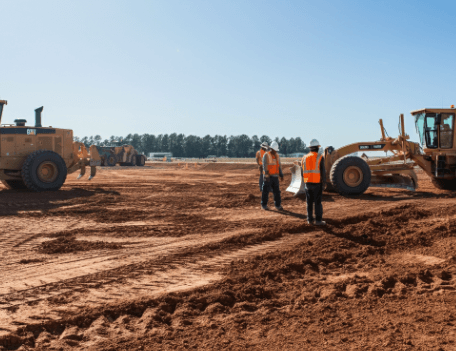Did you know that proper land preparation can increase construction efficiency by up to 30%? The process of land preparation for building is a crucial first step for any successful construction project. Whether you’re clearing your land, leveling it for stability, or testing the soil for suitability, each step directly impacts the durability and safety of your final structure. Steve Daria and Joleigh, renowned real estate investors and trusted cash buyers of land, emphasize that thorough preparation not only adds value to your land but also prevents costly delays or surprises down the road. Studies show that inadequate preparation is one of the most common causes of construction setbacks, underscoring the importance of this detailed process. This guide will walk you through the process of land preparation for building, highlighting essential steps and expert tips to ensure your project’s success. Thinking about selling your land for cash? Steve Daria and Joleigh are here to help streamline your transaction and offer trusted advice every step of the way. Don’t miss the opportunity to start your project on the right foot. Book a free discussion with Steve and Joleigh today and take the first step toward making your building dream a reality!
Key Points
- Clear and Level the Land: Begin by removing debris, trees, and any obstructions from the site. This ensures you have a clean slate, while leveling the surface creates the foundation for a stable and secure structure.
- Conduct a Soil Test: Test the soil to determine its suitability for the type of structure you plan to build. Understanding the soil’s composition helps you make decisions about foundation type and drainage systems.
- Establish Proper Drainage: Design and implement a drainage system to manage water flow and prevent pooling. Effective drainage protects the foundation and ensures long-term durability for your structure.
- Check Zoning and Permits: Before commencing construction, verify zoning regulations and obtain all required permits. Adhering to local codes avoids legal complications and ensures the project progresses smoothly.
- Plan Access and Utilities: Map out access roads, utility connections, and essential services, such as electricity and water. Proper planning reduces delays and ensures your site is ready for construction without interruptions.
What is land preparation for building?
Land preparation for building involves preparing a piece of land so that construction can start safely and efficiently.
This process often begins by clearing the land of trees, rocks, debris, and any other obstacles that could hinder construction.
Next, the land may need to be leveled to create a flat, stable surface on which a structure can be built.

Soil testing is another essential step in determining whether the ground is safe and suitable for the planned type of construction.
Proper drainage systems are then designed to prevent water from pooling and protect the building’s foundation.
During the process of land preparation for building, examining local zoning regulations and securing the required permits are essential steps.
These steps ensure the construction complies with legal requirements and avoids future complications.
Finally, utility connections, such as water and electricity, and access roads are planned to make the site fully functional.
By methodically preparing the land, you set a strong foundation for construction success and avoid costly problems later on.
Get Started: Get Your Cash Offer Below…
We are direct land buyers. There are no commissions or fees and no obligation whatsoever. Start below by sharing where your property is and where we can send your offer…
What tools are used for land preparation?
Land preparation requires a variety of tools to ensure the site is ready for construction.
Heavy-duty machines, such as bulldozers and excavators, are often used to clear land of obstacles like trees, rocks, and debris.
Grading equipment helps level uneven ground, creating a stable and even surface for building.
For deeper groundwork, trenches can be dug using trenchers, which are ideal for creating drainage systems.
Soil compactors or rollers are essential for compacting the soil tightly, thereby enhancing its strength and stability.
Hand tools like shovels, rakes, and wheelbarrows play a crucial role in refining details and managing smaller tasks with precision throughout the process.
Additionally, soil testing kits or professional laboratory equipment are used to determine the quality of the soil and its ability to support a structure.
Planning for utilities often involves specialized tools, such as trench diggers, to prepare for water, electrical, and sewage connections.
Using the right tools in the process of land preparation for building ensures that the land is properly cleared, stable, and ready for a strong, long-lasting project foundation.
How do I test the soil for construction?
- Start with a Visual Check: Inspect the site for visible issues, such as large rocks, tree roots, or pooling water. This helps identify obvious problems that could affect construction stability.
- Conduct a Soil Density Test: Determine the soil’s compaction to ensure it can support the weight of your structure. A professional service or handheld tester can give accurate results for this critical step.
- Assess Moisture Levels: Utilize a moisture meter to determine whether the soil is too wet or too dry, as imbalanced moisture levels can weaken the foundation’s stability. Balanced moisture is key for building stability.
- Perform a Soil pH Test: Check the soil’s acidity or alkalinity to avoid issues with concrete durability and landscaping. Affordable pH testing kits make this process quick and easy.
- Send Samples for Lab Analysis: Lab tests provide a detailed report on soil composition and load-bearing capacity. This ensures the process of land preparation for building meets all safety standards before construction begins.
What are the costs associated with land preparation?
The cost of land preparation depends on factors like the size of the land, its condition, and the tasks needed to get it ready for construction.
The first step in land preparation often involves clearing trees, rocks, and debris.
The cost of this process can fluctuate based on the density of vegetation in the area.
Soil testing, an essential part of the process of land preparation for building, adds to the total expense, with basic tests being less expensive than detailed lab analyses.
Leveling or grading the land is next, and this often incurs additional costs, especially if the terrain is uneven or challenging.
Proper drainage systems prevent water damage, protect structural integrity, and ensure long-term safety.
Compliance with local zoning laws and acquiring necessary permits also involves fees that must be accounted for.
If heavy equipment, such as bulldozers, excavators, or trenchers, is needed, the rental or operational costs can be substantial.
Hiring professionals, such as engineers, surveyors, or contractors, to oversee the preparation process increases expenses but ensures that everything is done correctly, thereby avoiding expensive mistakes during construction.
These combined costs are an investment toward a stable and safe foundation for your project.
How long does land preparation take?
- Clearing the Land (1-7 Days): The first stage involves removing trees, rocks, and debris, which can take a few days to a week, depending on the land size. Using machinery like bulldozers speeds up the process but requires careful planning to clear the area effectively.
- Conducting Soil Tests (2-5 Days): Testing the soil for its strength, moisture levels, and pH is a critical step in the land preparation process for building. Lab results usually take about two to five days, depending on the complexity of the tests required.
- Leveling and Grading (2-10 Days): Leveling the land to create a stable, even surface can last from a couple of days to over a week. Challenging terrains or larger plots may require additional time and specialized equipment, such as graders.
- Installing Drainage Systems (5-10 Days): Proper drainage systems are installed to prevent water damage, and this step in the land preparation process for building typically takes about 5 to 10 days. Larger projects or intricate drainage designs could require more time to complete accurately.
- Obtaining Permits and Planning Utilities (7-21 Days): Securing the necessary permits and marking utility connections are time-consuming but vital steps. These tasks may take one to three weeks, depending on local regulations and approval processes.

What should I do after completing land preparation?
After completing the process of land preparation for building, you should ensure everything is set for the next steps in your construction project.
First, double-check that all drainage systems are in place and functioning properly to prevent water-related issues.
If soil testing revealed any specific requirements for your structure, confirm that these have been addressed.
Next, review any permits or regulations to make sure you continue to meet local building codes.
Coordinate with your utility providers to connect essential services, such as electricity, water, and sewage systems, to the site.
It’s also a good time to finalize your construction plans and timelines with your contractor, ensuring everyone is clear on the schedule.
If you need materials delivered, organize these now so they’ll arrive when needed.
Additionally, secure the prepared land by installing temporary fencing if necessary to protect the site and maintain its safety.
Finally, consult with a construction professional before starting work to ensure that all aspects of the land preparation process for building have been completed correctly.
For further guidance or to confidently begin the building phase, reach out to industry experts or trusted contractors today.
**NOTICE: Please note that the content presented in this post is intended solely for informational and educational purposes. It should not be construed as legal or financial advice or relied upon as a replacement for consultation with a qualified attorney or CPA. For specific guidance on legal or financial matters, readers are encouraged to seek professional assistance from an attorney, CPA, or other appropriate professional regarding the subject matter.
